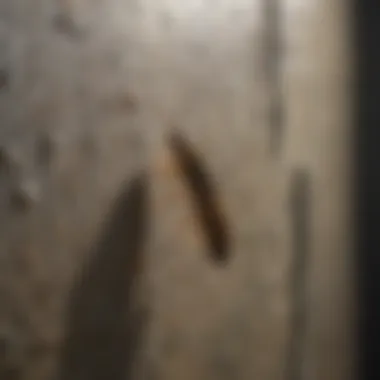Unveiling the Intriguing Factors Behind Silverfish Infestations in Homes


Preventive Pest Control Strategies
When considering preventive pest control strategies for your home, there are key areas that must be addressed to minimize the risk of infestations. One crucial aspect is House Exterior Protection where tips for sealing cracks, clearing debris, and preventing pests from entering should be followed diligently. By maintaining a robust defense mechanism on the exterior, you create a barrier that deters pests, including silverfish, from gaining entry into your home.
Moving on to Yard Maintenance, essential yard care routines play a significant role in keeping pests at bay. Regular maintenance tasks such as mowing the lawn, trimming shrubs, and removing standing water help eliminate potential breeding grounds for silverfish and other pests. Implementing methods to keep your yard pest-free is essential for preventing infestations from developing and spreading to your home.
Indoor Cleanliness is also paramount in preventing silverfish infestations. By adhering to expert cleaning tips and techniques, you can create an environment that is less hospitable to pests. Consistent efforts in maintaining a pest-resistant indoor space through regular cleaning and decluttering go a long way in deterring silverfish from establishing a presence in your home.
Proper Garbage Disposal is another crucial aspect of preventive pest control. Efficient waste disposal methods not only help in maintaining overall cleanliness but also eliminate food sources that attract silverfish and other pests. Emphasizing the importance of proper garbage disposal practices educates homeowners on one of the fundamental steps in pest prevention.
In addition to the essential strategies mentioned above, exploring other Pest Prevention Strategies can offer innovative ways to safeguard your home against potential infestations. By combining traditional methods with modern approaches, homeowners can create a comprehensive pest control plan that addresses various vulnerabilities and minimizes the risk of pest intrusion.
Introduction
Silverfish infestations can be a challenging problem for homeowners, given their destructive feeding habits. Understanding what attracts these silver-colored, teardrop-shaped insects into your living spaces is crucial in mitigating infestations. By delving into the environmental conditions and food sources that entice silverfish, you can take proactive measures to safeguard your home.
Overview of Silverfish
Silverfish are unique insects characterized by their fish-like appearance and quick, darting movements. These nocturnal creatures prefer to reside in dark, damp areas, making them commonly found in basements, attics, and bathrooms. Their sleek bodies are coated in silver scales, enabling them to move swiftly and hide effectively in narrow cracks and crevices. Despite their harmless nature to humans, silverfish pose a threat to household items due to their feeding habits.


Signs of a Silverfish Infestation
Identifying a silverfish infestation early is key to preventing extensive damage to your belongings. Common signs include finding their silvery shed skins in secluded areas, holes in paper products, such as books or wallpaper, and yellow stains on fabric. Additionally, spotting these swift insects scurrying away when you turn on the lights during the night is a telltale sign of their presence. By staying vigilant and recognizing these indicators, you can promptly address and eliminate infestations.
Importance of Identifying Attraction Factors
Recognizing the factors that draw silverfish into your home is essential for effective pest management. High humidity levels provide an ideal environment for silverfish to thrive, as they require moisture to survive. Dark and damp spaces offer these nocturnal insects the perfect conditions for shelter and reproduction. Understanding that silverfish are attracted to starchy materials, such as paper, glue, and certain fabrics, highlights the necessity of proper storage to minimize infestation risks.
Environmental Factors
In this chapter, we delve into the critical role of environmental factors in attracting silverfish into households. Understanding the impact of the environment on silverfish behavior is crucial for effective prevention strategies. By examining key elements like humidity levels, dark and damp spaces, and temperature preferences, homeowners can develop a comprehensive approach to deter silverfish infestations.
Humidity Levels
Silverfish have a notable inclination towards thriving in environments characterized by high humidity levels. This preference stems from their physiological makeup, which is adapted to moisture-rich conditions. The presence of excess moisture creates an ideal habitat for silverfish, promoting their breeding and survival. As silverfish rely on moisture for sustenance and reproduction, areas with high humidity levels become attractants for these pests. Managing humidity levels below 50% is essential to discourage silverfish infestations.
Dark and Damp Spaces
Another key factor that lures silverfish into homes is the availability of dark and damp spaces. Basements, attics, and bathrooms exemplify the ideal environments for silverfish infestations due to their dim lighting and humid conditions. The darkness provides silverfish with shelter and protection, while the dampness sustains their need for moisture. These secluded areas offer silverfish seclusion and a favorable climate, encouraging their presence and proliferation. Identifying and addressing such spaces in the household is crucial for preventing silverfish infestations.


Temperature Preferences
Silverfish exhibit peak activity between temperatures of 70-80 degrees Fahrenheit. This temperature range optimizes their metabolic rates and enhances their foraging capabilities. The preference for moderate warmth enables silverfish to efficiently search for food and shelter, contributing to their survival in indoor environments. Understanding silverfish's affinity for specific temperature ranges allows homeowners to adjust climate control settings to deter these pests. Maintaining temperatures outside the preferred range inhibits silverfish activity and reduces their attraction to residential spaces.
Food Sources
Understanding the significance of food sources is crucial in tackling silverfish infestations within residential spaces. These tiny pests have a particular affinity for starchy materials, making it imperative to address this aspect to mitigate infestation risks effectively. By comprehensively exploring the types of food sources that attract silverfish, homeowners can take proactive measures to safeguard their living environments.
Starchy Materials
Silverfish demonstrate a notable preference for starchy items like paper, glue, and fabric. This dietary inclination plays a pivotal role in their infestation patterns within homes. Understanding the specific foods that entice silverfish is essential in devising strategies to deter them effectively. The allure of starchy materials to silverfish emphasizes the importance of protecting such items to prevent infestations effectively. Homeowners must be vigilant in managing and securing these materials to minimize the risk of silverfish infiltration.
Other Silverfish Habitats
Silverfish tend to gravitate towards areas near their food sources, establishing habitats in proximity to their preferred sustenance. This behavior underscores the close connection between silverfish distribution and accessible food supplies. Recognizing the tendency of silverfish to inhabit areas close to their nutrition sources is essential in pinpointing potential infestation hotspots within homes. By identifying and addressing these habitats, homeowners can disrupt the conducive environments that facilitate silverfish breeding and proliferation.
Lingering Food Residues
The presence of lingering food residues acts as a potent attractant for silverfish, paving the way for infestations to take root. Food remnants left unattended serve as beacons for these pests, drawing them into living spaces and fostering population growth. Mitigating the risks posed by lingering food residues requires thorough cleanliness and proactive maintenance practices. By promptly addressing and eliminating food remnants, homeowners can significantly reduce the likelihood of silverfish infestations, creating inhospitable conditions for these unwanted intruders.


Preventive Measures
Preventive measures are crucial in combating silverfish infestations. By taking proactive steps, homeowners can prevent the entry and proliferation of these destructive pests within their living spaces. Implementing effective preventive measures not only safeguards the home environment but also reduces the likelihood of extensive damage caused by silverfish. It is imperative to address key factors that attract silverfish into homes and create an inhospitable environment for their survival. Emphasizing preventive measures can significantly minimize the risks associated with silverfish infestations. A comprehensive approach to prevention involves a combination of strategies tailored to deter silverfish effectively.
Dehumidification
Maintaining indoor humidity levels below 50% is a critical aspect of silverfish prevention. By controlling humidity levels, homeowners can disrupt the favorable conditions that attract silverfish. High humidity provides an ideal breeding ground for silverfish, encouraging their presence and rapid reproduction. Through dehumidification, the excess moisture that sustains silverfish is eliminated, creating an environment that is less conducive to their survival. By reducing humidity, homeowners can effectively deter silverfish infestations and protect their living spaces from damage.
Elimination of Clutter
Reducing hiding spots for silverfish by decluttering living spaces is a practical strategy for preventing infestations. Clutter provides hiding places for silverfish, allowing them to thrive undetected. By decluttering, homeowners remove potential shelters and breeding grounds for these pests, making it challenging for silverfish to establish a presence in the home. Eliminating clutter not only hinders silverfish activity but also enhances cleaning efforts, reducing the likelihood of food remnants that may attract these pests. Maintaining a clutter-free environment is essential in preventing silverfish infestations and protecting the home from damage.
Proper Food Storage
Storing food items in airtight containers is a key practice to prevent access to silverfish. Inadequately stored food serves as a prime attraction for silverfish, drawing them into homes and sustaining their presence. By using airtight containers, homeowners can limit silverfish's access to potential food sources, deterring them from infesting pantries and storage areas. Proper food storage minimizes the risk of contamination and spoilage caused by silverfish feeding activity, preserving the integrity of stored items. This preventive measure is instrumental in reducing the likelihood of silverfish infestations and maintaining a hygienic living environment.
Conclusion
In the realm of combatting silverfish infestations, the conclusion stands as a pivotal piece in fortifying one's home against these stealthy invaders. As we navigate the intricate web of environmental factors and food sources appealing to silverfish, the conclusion acts as the linchpin that ties together our knowledge and empowers us to take proactive steps. By fathoming the significance of adopting preventive strategies, homeowners can safeguard their sanctuaries from the clutches of these voracious pests. Moreover, the conclusion serves as a compass, guiding us towards a future where silverfish cease to be an ominous presence in our living spaces. It encapsulates the essence of our journey through the landscapes of humid crawl spaces and starchy feasts, offering a beacon of hope in the quest for a silverfish-free abode.
Taking Action Against Silverfish
Embarking on the voyage to combat silverfish requires a strategic approach that delves deep into the heart of their breeding grounds and foraging patterns. Taking action against silverfish necessitates a combination of vigilance, meticulous planning, and swift execution. By first identifying the telltale signs of infestation, one can preemptively strike at the core of the problem, disrupting the silverfish's sinister agenda. Implementing targeted measures such as sealing entry points and deploying natural repellents can form a formidable defense against these elusive pests. Furthermore, enlisting the aid of professional pest control services proves invaluable in eradicating entrenched infestations and fortifying the home against future incursions. As we unite in the battle against silverfish, each action taken serves as a bulwark against their encroachment, yielding a habitat devoid of their presence.
Final Thoughts
As we draw the curtains on our exploration of silverfish infestations, our final ruminations echo with a sense of empowerment and preparedness. The journey from ignorance to enlightenment regarding silverfish's allure into our residences equips us with the knowledge to repel their advances effectively. Our minds now armed with insights into their preferred habitats and dietary inclinations, we stand poised to uphold the sanctity of our homes. In the tapestry of final thoughts, woven with threads of resolve and foresight, we envision a future where silverfish no longer hold sway over our domestic realms. Let us carry forth this newfound wisdom as a shield, warding off potential infestations and preserving the tranquility of our living spaces for generations to come.



